May 10, 2023
I had all the good intentions to give a more details write up from the No Frills ride in mid-April after posting the video clips, but ended up finding more contemplation from that ride fitting for the blog I release through the website for the book I published (The Jael Finishing School for Ladies) — relating to life lessons not usually horse related. And so you could peruse that post here if you were interesting in those sorts of musings: https://jaelfinishingschool.wordpress.com/2023/04/18/giants-for-breakfast/
Meanwhile life continues to pick up on all fronts here at this end of nowhere that I call home and I let the video clips stand as the best representation of how the day went for us in the No Frills 55 for 2023. In short, the weekend was challenging, but we just kept moving until we finished and vetted through successfully for a positive start to the 2023 season.
Before we knew it we were at the door of the Biltmore weekend and hit the road to one of our favorite ride weekends practically in the neighborhood of dear friends Brandea & Abigail who were good enough to drop in to crew. I am so grateful for them- not only are they incredibly helpful around camp and manning the vet holds, but they are family for me and encouraging to my spirit to be around. They are a true blessing!

As challenging as the No Frills ride was, the Biltmore ride was equally smooth.
The start to the trip engaged a mental journey that I have been on for years about what we do with these equine creatures— what we should, or should not do with them. I have considered that they being an animal we invest in, should do what we ask of them- regardless of how fun and engaging they find the work… and I’ve swung at times to the opposite thought that they should only do what they are willing to do without force and given the ability to choose. That side gets difficult because most horses, if given a real choice, are likely to prefer field and friends and food to whatever adventure we have in mind for them. How on earth do I make getting on a trailer that the smart mare noticed had been packed full of event gear for the entire day previous, better than staying with the family and relaxing in the grass?
I have come to a more balanced understanding currently that there are some parallels to a human journey, and without getting too anthropomorphically out of balance I hope (because a horse is not a human); I think we too, if given a real choice, might choose food and friends over a more difficult task that is set before us for some greater purpose if we were honest. There isn’t anything wrong with that, but our human brains are able to decide to take on a thing instead of not getting off the couch; oftentimes there is incentive behind the choice like needing resources (a job), or not wanting to be quite so unhealthy (exercise), or in the best cases answering a need someone else has (love) and so we get out of our comfort zones to whatever extent we will and do the thing before us.
In some similar way I believe that a horse is meant to partner with us humans when done well. Unfortunately it’s often not done well (I am a living example of this at times), and to make an even more complex point, done well can be in the eye of the beholder and have a sliding scale depending on the horse, the human, the circumstance, and the beholder. Khaleesi and I engage in a sport that is challenging and I believe the mare to be equal to the challenge if supported by her wise and honorable human (that would be me in case you’re wondering). And so with greater confidence than I’ve had in previous years of doubt, when she asked me at the ramp of the trailer: do we really have to do this thing? I was able to reply: yes, we really do, and I promise in the end you will thrive and we will do it together, and it will be hard, but we will prevail- whatever comes. And I will do my best to honor you in the journey best I can. Now lets go.
And after being satisfied with my answer, on the trailer she walked… slow and relaxed… as she does all things she is not afraid of.
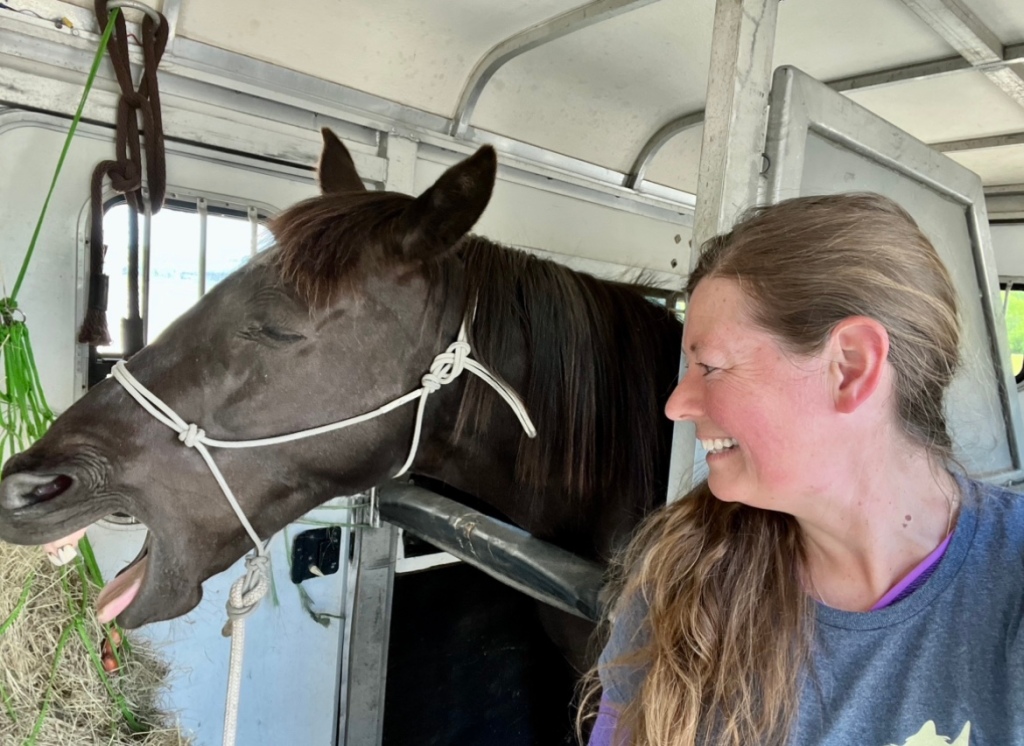
I never arrive early enough to this ride to get a spot in main camp, but I’ve begun to like the relaxed setting of satellite camp. We don’t have designated spaces here and can spread out. It’s a farther walk to main camp and the activities, but that is a small price to pay. Camp is along the French Broad River on the Biltmore Estate Equestrian Center. There was a beautiful full moon that came up while we settled in with our late dinner and except a brief time K was unusually unsettled for a reason we never understood (and after I took her out for a hand walk she reentered), it was an easy lovely evening.
Ride day meant up before dawn getting prepared for the 7am ride start for the 55 mile competition. We all worked together easily to have me in the saddle by 6:30am and heading up to check in at main camp by the starting line.
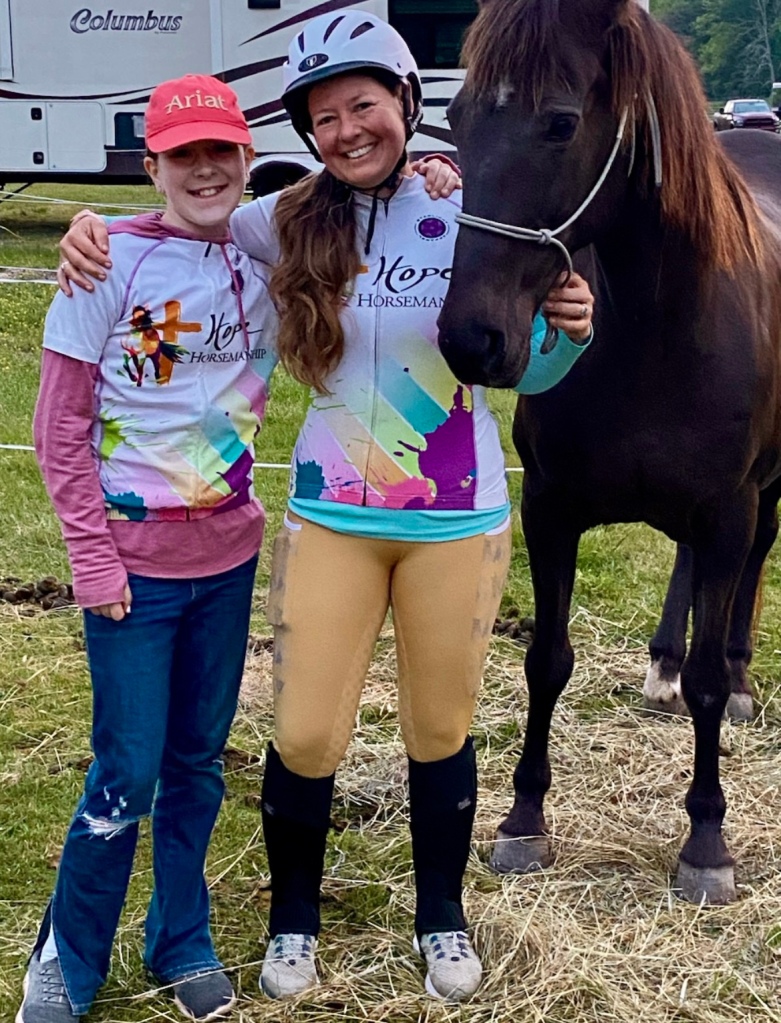
I realize many riders prefer to head out of camp in a leisurely relaxed manner after the first horses take up the immediately open trail. Khaleesi has very little race brain and tends to keep her head about her, we need all the incentive and all the clock time we can get, so I go out as soon as the trail is open for competition. I realize wise counsel often suggests holding the horse back so that later in the day there are yet some energy reserves to tap into. My particular horse doesn’t seem to tap out that deep resource and though she is not naturally a speedy equine, she does have longevity and if I can get some miles knocked out early in the cool of the day, I am apt to take it. Khaleesi is only 1/4 Arab (considering how solid her mind is I’ve had many a joke about the fact that her Arab and Saddlebred halves are not likey the genetics she is most closely associated) We have been known to put money in the time bank in the morning that she draws on when the heat of the day calls up the debt in the afternoon. It’s nice to have the padding.
We finished the roughly 15 mile loop in under two hours with an average speed of 8 mph. She didn’t feel exciting, but was solid and strong. Her pulse was down at 56 by the time we got the saddle off, and we had no trouble with the vet or the hold.
After the 50 minute mandatory hold we headed back out for the second and longest (22 mile) loop. This loop she was mentally not interested in going out to ride. I find it revealing that when her mind is not engaged in the work she can convince me she might die… Yet when we were overtaken by a small group of horses about six miles into the loop, she was clearly inspired and indeed she had plenty of life in her. It’s normal for us to ride the majority of an event alone, but the Biltmore has so many people doing various distances on various overlapping trails (25, 55, 75, 100 miles) we often rode along with people even for short stretches of overlapping trail.

This is one valuable key that has been in my mind for months. A horse will only perform as well as her mind is in the game.
Since meeting Harry Whitney in February, when he talked about mental lameness, I had an “aha” moment about a strange phenomena I see on occasion that has, in years past, concerned me for a physical injury. It’s the mystery lameness that is hard to duplicate. Occasionally now, I can connect with times she is not thinking forward down the trail, she has this hop that comes in the trot that feels like she is going off. It shows up less and less over recent years, but I have still noticed it from time to time. Harry shared some experiences about similar strange gaits that no vet could sort out and no constructive farrier work could address; when he began to work with the horse focused on sorting out the issues in the horse’s mind, the lameness or gait dissolved and the horse came right. Now if that strange little gait appears I address it as a mental problem- her mind is somewhere else. I am not suggesting she is trying to trick me into thinking she is lame I am saying she is thinking backward, behind her where she left her mind at the trailer, at the barn, in the field or at camp, and the forward motion I am physically insisting on is in conflict with where her brain is. This can show up in a strange gait where the two worlds collide in an off-kilter hop that feels like a lameness. In short- the horse has lost her mind, and it’s my job to try to reunite them but getting her mind present with our bodies (because I’m not heading back to camp to retrieve it!).
So I begin addressing her mental state which is not so simple to write about in a blog, and I’m still getting more proficient at, to encourage her to get with me, get her thoughts moving along the trail, and get back to work. When that happens the strange little hop gait does not reappear.
We finished the second loop in just under three hours with another smooth vet check and hold. Average speed for that according to the GPS was around 7.5mph which is pretty good for us.

The final loop is the long 18 miles. It’s long because it’s in the heat of the day, repeating the exit and return to camp trails, and though she was more willing this round to leave camp alone, she was not particularly enthousiastic about it. I have found myself in this same place from time to time in life- the job is not too hard, but it is bit tedious and so we just keep moving through without gusto because it will eventually end and the only way to get to the end is to go through. And so I reminded her to keep trotting, even if it’s slow, we just finish this last loop, and then you can relax, eat all you want, and take a nap. This loop she took a slight bit longer than the second, but an average pace of about 6.5mph which was respectable and got the job done.
In the hair mineral analysis testing over the last year, her adrenal levels have suggested that she is a horse not prone to speed, but to endurance. It seems it’s preferable to have them more balanced, but considering this sport is endurance, and considering my hope is that we are able to compete the single-day 100 at some point, maybe I have just the right creature for it after all. I have noticed that she may not be flashy, but she can keep going. All through the day she reminded me of the energizer equine so to speak, she just kept going. Balanced, solid, true to form, steady, trotting along in a regular rhythm.
I have been working on polarized training with her now intentionally for about a year. I do notice a difference in the events we do. It worries me just a little because I do not feel the energized quickness I feel she had sometimes in years past- but that did not last all day. Now it’s less remarkable and exciting, but I am finding a depth that shows up to replace the eagerness I’ve felt before. So far it’s a depth that has served us until the finish line and I haven’t come to the end of it. I have been told this kind of training builds an engine. I have felt the freight train in times past, and that is exciting, now as we ride through the miles with less excitement, I felt instead the little engine that could. Less like the impressive bullet train, and more like the work engine that is dependable to carry the load across the miles and keeps chugging along though the changing scenery without faltering. She just keeps going.
When we crossed the finish line I was surprised to see we had finished in 7th place (out of 33 starting that morning). The ride did not feel particularly victorious as we went through it, and 7th place bumps us into the top 10 group which we are generally just out of (our usual finishes are in the teens, generally solid mid-pack).
Next we had to pass the final vet exam or the placement meant nothing. Once again this was smooth. I was particularly pleased how well she came through. In the last few miles I felt her begin to slow on steeper downhills taking more care, or she would slip on occasion which told me she was beginning to tire. I wondered if she was getting tight muscles from the constant up and down of the Biltmore trails. I also felt personally exhausted from her somewhat jarring trot (she has a decent trot, but it’s no western pleasure jog) and we’d been at it all day with very few intervals of cantering and even less walking. I try to sit the trot as often as it’s possible because of an imbalance I’m working on with her trot diagonals and a one-sided strength I built in years previous. All this to say, I also wondered how her back would feel from me attempting not always successfully to not bounce around on her yet stay loose and give her body the ability to move in the freedom she needs to work in strength and efficiency. Though I have come a long way, my riding still has room for improvement and I do get tired over time.
In the final vetting, I watched the vet (Ken) pressing all around her looking for any signs of pain or discomfort, and I was pleased to notice her relaxing into all the poking, prodding and pressing as if it might be a massage. Not a sign of back soreness and he gave her ‘A’ scores on muscle tone all around. Her legs were in good shape, hydration was an ‘A’, and gut sounds were decent (one quadrant was a “minus” the rest were “plus”).
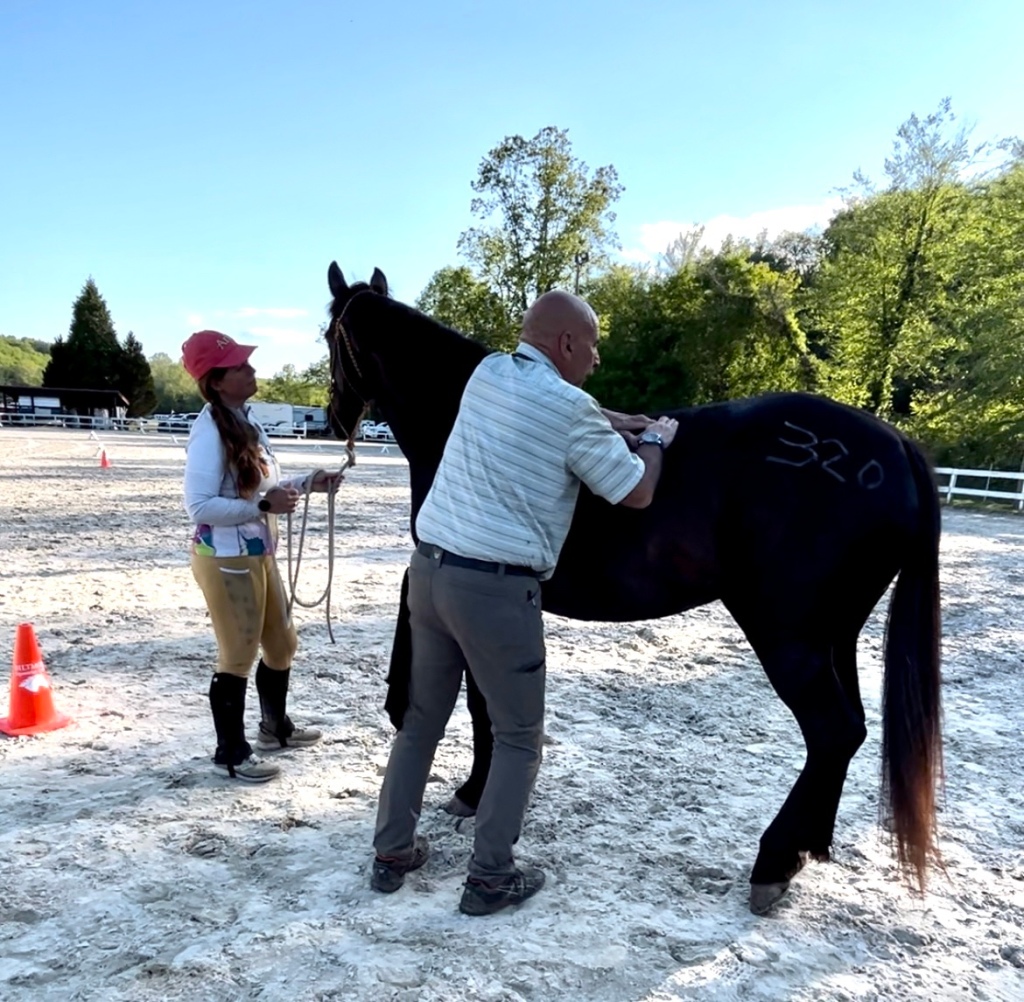
She had eaten herself along the entire last loop which had been at times annoying for me trying to keep moving but I was glad to know she was feeling good because an exhausted horse will lose interest in food. Not only did we pass but he gave us a time to present for “Best Condition” which would be the horse that came through in the top 10 and finished also very strong. This would be our first time to show up for that potential honor and I was glad for the experience.
Once again: the mental key.
I knew my horse was in good shape and she spent the time window waiting for the best condition appearance eating grass and being brushed by Abigail who since we were not at our campsite used her own personal hairbrush. She was determined to ensure Khaleesi was well groomed and looking fabulous for the moment. Thank you Abigail, your efforts of caring for K through the day were over and above!

When we went to present it was in the very fancy dressage arena with the very expensive footing that had been closed off to general use. There was not a way we could have gone in there beforehand, nor did I consider trying. We entered and the examination began showing basically the same things the initial exam did- she was in good shape. Then we had to trot out and back, and around a large circle in both directions… Seeing the movement of the horse is a vital part of the scoring process and this is where I saw the mental part break down.
As we began to move through the arena which was littered with cones and other arena paraphernaliaa… and on the other side of the arena fencing were tents with vendors, cars and trailer and trucks moving about and in this slightly new environment my mare’s brain went all over the place… what is that white thing? Did that tent just flap in the breeze? Will it fly over here and crash into us? Where is my human going? Oops, I almost ran into her… oh! I just stepped on the orange cone and smashed it into the expensive blinding white footing… hey, she is running back now… better follow along or I’ll get yanked by the lead rope… wait, a circle, she’s changing sides- did I just almost hit her head with my chin?
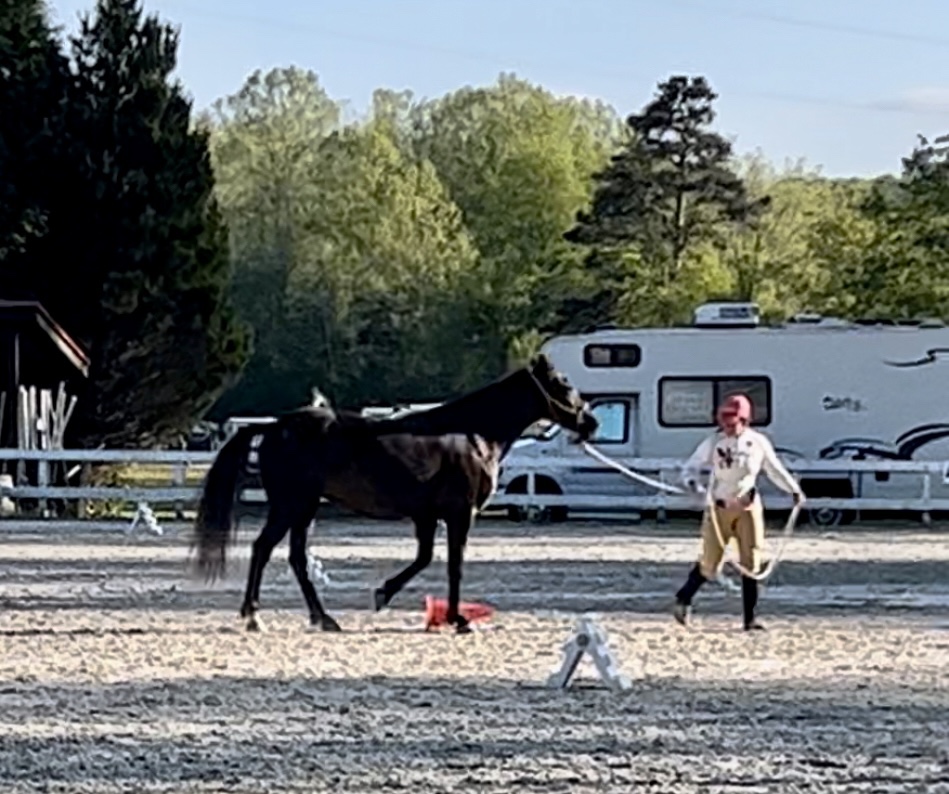
Oh yes, this is what our presenting was like. Considering I know what my mare can do when her brain is present- and I was not able to bring her back in that exact moment and do what we were called upon to do I had to laugh. It is good to see new things to grow into ahead of you.
On the point scoring side the fact we were about an hour behind the first horses to finish even if we were in fabulous shape we’d have to be exceptional to have taken this award- but the experience was really good for us. Ken was incredibly kind and lighthearted- first telling me that running over the cone is immediate disqualification which then he laughed and said of course not really… and he gave us great insights on how to present the horse at her best next time. He told us that considering we may find ourselves in this position now more often, we should practice and be ready.
I suppose time will tell.
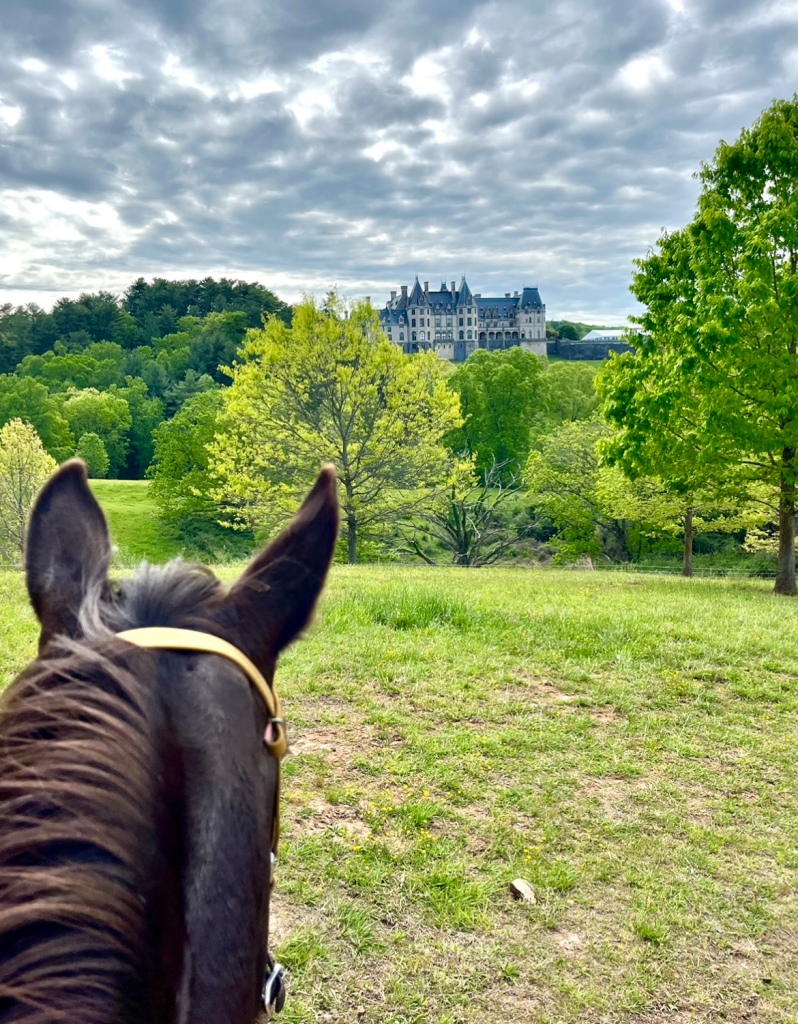
Regardless of where the path takes us on our journey to the single-day 100, I am grateful for the gift of a highly successful ride. I became aware after returning home that it as seven years ago that we took our first ride to the Biltmore to try for our first ride in the “50-mile” distance (it was a 55 mile) and this ride, seven years ago was our entrance into this sport’s foundational distance. Previously we had done the “Limited Distance” categories of 25/30 mile distances. Seven is a good number. It often symbolizes a completion (a seven day week…) sometimes a promise (seven colors in the rainbow)…
I am hopeful that the things we have spent years putting into practice, and believing that with patience in staying the course even as the improvement was slow, they would create a powerful horse that would continue to get better and not break her down for a relatively short career window and a horse with chronic injuries in the middle of her life. [I explain some of our foundational pillars in the post Top of the ninth if you want to go back to read it]
My hope is this commitment to doing things the slow, patient long way are beginning to bear fruit for us. I am excited about the key I believe gives access to all the important doors, the mind, and I’m looking forward to how increasingly learning to work this key will bring about more and more strength in my mare.
As a post-script, the other key from this weekend I believe, will come from our willingness to volunteer for a study that was offered. Blood and feces were taken at intervals to research the potential of gut permeability (leaky gut) in equine athletes. While the results of the study itself may take some time to see, each participant is getting a personal blood work panel including “a complete serum biochemistry panel including electrolytes, muscle enzymes, kidney values, and lactate before and after the race” which will come within 10 days of the event. Considering we have been working on the internal functional side of the horse for a year now addressing nutrition and whole health (including gut health and potential inflammation) I am really looking forward to what the blood work before (which would be “normal” for us) and after the ride tell us, and how that might instruct any changes to supporting Khaleesi both day to day (normal) and during a race.
Meanwhile… we relax a bit this week and try to get some early work done as we have a month until the Old Dominion weekend in June.

Thanks for coming along for the ride… until next time…

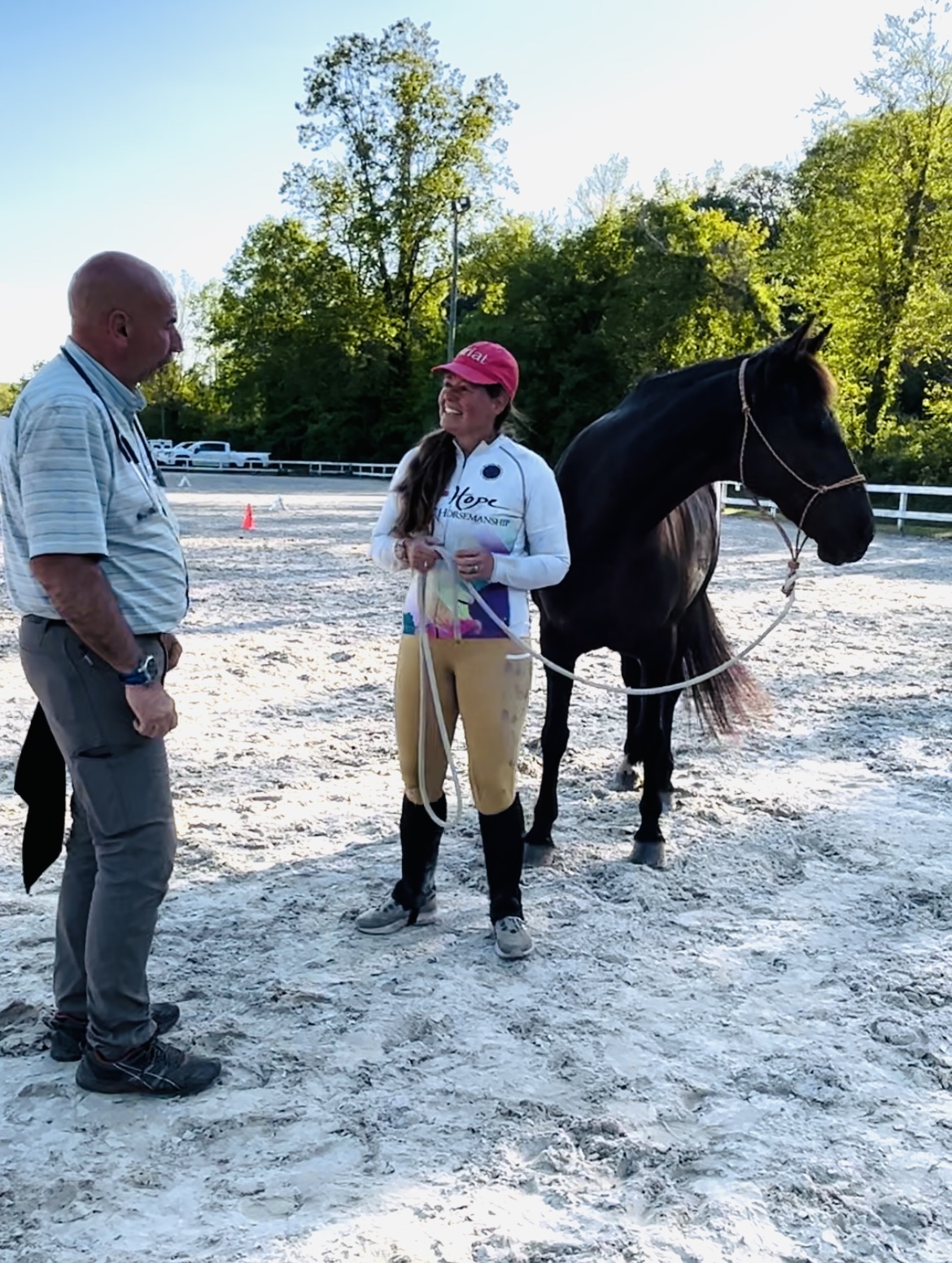
As always, incredibly well put. I hugely appreciate that paragraph about doing this sport together well, even when most folks and horses choice is the “stay in the field/on the couch” one, but it’s still okay to push both of you past that to see what the the trail offers if you’re well prepared for it. I failed Tarma after our first 50, I didn’t take care of myself well enough to be able to give her the aftercare she deserves, so my goal for the next one is to bring myself through well enough to take care of her. One of the many reasons I love endurance is it’s pretty easily clear if a horse wants to do this sport or not; Tarma was thrilled to go back out for a third loop, whereas my friend has found her gelding doesn’t want to do 50s anymore but is happy loafing through an LD. Also, I love your team shirts!
LikeLiked by 1 person